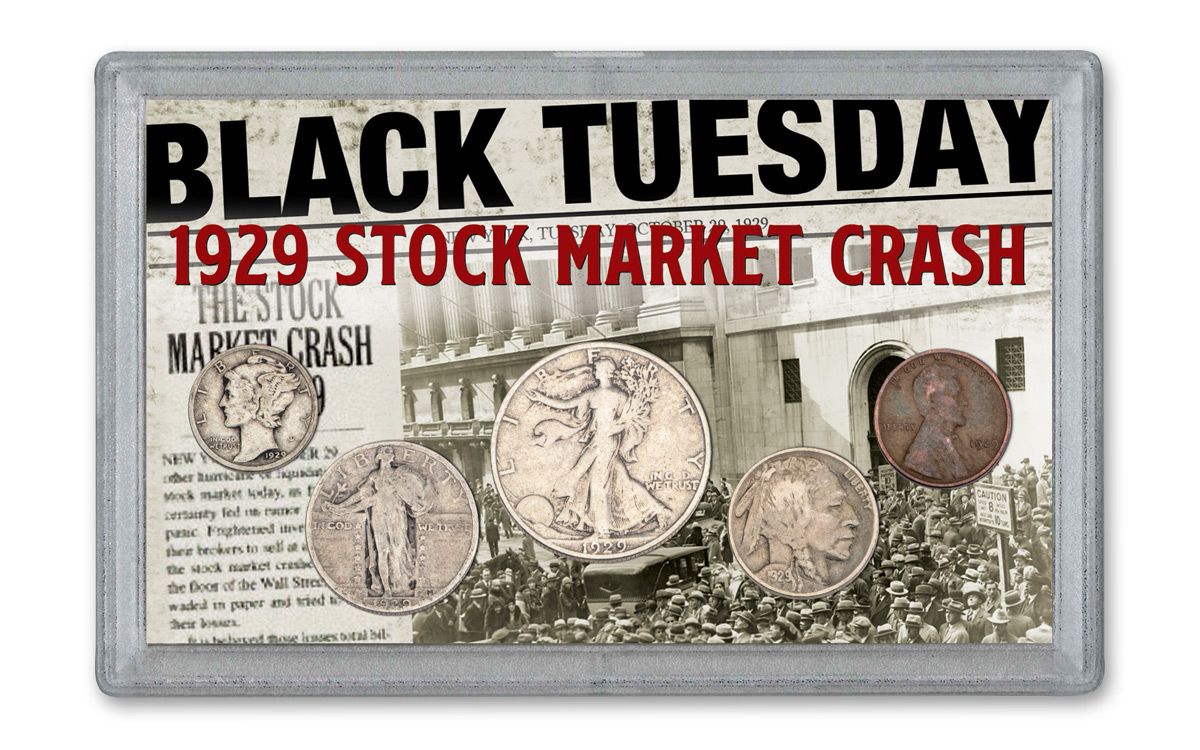

Finance
What Led To The 1929 Stock Market Collapse?
Published: November 24, 2023
Discover the cause of the infamous 1929 Stock Market Collapse and unravel the secrets of the finance industry's greatest downfall.
(Many of the links in this article redirect to a specific reviewed product. Your purchase of these products through affiliate links helps to generate commission for LiveWell, at no extra cost. Learn more)
Table of Contents
Introduction
The stock market collapse of 1929, also known as the Great Crash, was a catastrophic event that had far-reaching consequences for the global economy. The collapse marked the beginning of the Great Depression, a period of severe economic downturn that lasted for years. Understanding the factors that led to the stock market collapse is vital for comprehending the complexities of the financial system and its vulnerabilities.
During the 1920s, the United States experienced a period of unprecedented economic growth. The stock market became a symbol of optimism and prosperity, with people investing large sums of money in the hope of making quick profits. However, beneath the surface, there were several underlying issues that ultimately led to the crash.
Excessive speculation was one of the key factors that contributed to the collapse. Investors engaged in rampant speculation, buying stocks purely based on the belief that prices would continue to rise. This speculative frenzy created a bubble that was bound to burst.
Another significant factor was the practice of margin buying, which allowed investors to borrow money to purchase stocks. While this could lead to substantial profits in a rising market, it also amplified losses when prices started to decline. When the market began to falter, investors who had borrowed heavily found themselves unable to meet their margin calls.
The stock market was also plagued by overvalued stocks. Many companies were overhyped, with their stock prices far exceeding their actual worth. This disconnect between stock prices and the underlying financial health of companies made the market highly vulnerable to a correction.
The agricultural depression was yet another factor that weakened the economy. Farmers were facing declining prices for their products, leading to widespread financial hardship. This had a ripple effect on other sectors of the economy and added to the overall instability.
Internationally, economic instability and the aftermath of World War I further exacerbated the situation. The war had left European economies in shambles, and the United States was heavily invested in these countries. When European economies took a downturn, it directly impacted the American economy.
The weak state of the banking system also played a role in the collapse. Banks were involved in risky practices and had invested heavily in the stock market. When the market crashed, many banks were unable to recover and subsequently failed.
Government policies, or the lack thereof, were also a contributing factor. The laissez-faire approach taken by the government meant that there were no regulations or safeguards in place to monitor and control the stock market. This lack of oversight allowed for rampant speculation and manipulation.
The culmination of these factors came to a head on October 24, 1929, also known as Black Thursday. On this day, panic selling ensued, and stock prices plummeted. Investors lost billions of dollars, wiping out fortunes and leading to widespread financial ruin.
The aftermath of the stock market collapse was devastating. The economy spiraled into the Great Depression, with unemployment soaring and businesses collapsing. It took years for the economy to recover, and the effects of the collapse were felt for decades to come.
Understanding the causes and consequences of the 1929 stock market collapse is crucial for ensuring that history does not repeat itself. By examining the mistakes made in the past, we can work towards creating a more stable and resilient financial system.
Excessive Speculation
One of the key factors that contributed to the collapse of the stock market in 1929 was excessive speculation. During the 1920s, the stock market became a symbol of prosperity and many people jumped into the frenzy of buying and selling securities. Investors were lured by the potential for high returns, leading to an environment characterized by rampant speculation.
Speculation occurs when investors buy stocks with the expectation of selling them later at a higher price, without considering the underlying value of the company. This speculative activity drove up stock prices to unprecedented levels and created a speculative bubble.
As stock prices continued to rise, more and more people were enticed to join the market, hoping to make a quick fortune. People from all walks of life, from wealthy businessmen to ordinary workers, invested their money in stocks, often borrowing heavily to do so. The euphoria surrounding the market helped fuel this speculative behavior, as the belief that prices would continue to rise became deeply entrenched.
However, this speculative frenzy was unsustainable. The disconnect between stock prices and the actual value of companies became glaringly obvious. Many stocks were trading at inflated prices, far beyond their intrinsic worth. The market was flooded with overhyped and overvalued companies.
This excessive speculation created a dangerous situation where the market was precariously held up by investor sentiment rather than fundamental value. As long as investors believed that prices would continue to rise, the market remained stable. But when doubts began to emerge and confidence wavered, the inevitable collapse was triggered.
Furthermore, the practice of borrowing money to invest, also known as buying on margin, contributed to the speculative frenzy. Margin buying allowed investors to purchase stocks by putting down only a fraction of the full value, with the rest borrowed from brokers. This leverage magnified both potential gains and losses.
In a rising market, buying on margin could lead to substantial profits as the borrowed money amplified returns. However, when stock prices started to decline, investors who had borrowed heavily found themselves in a precarious position. Margin calls were issued, demanding additional funds from investors to cover losses or maintain the required margin.
As panic set in and stock prices plunged, many investors could not meet these margin calls, leading to forced liquidation of their holdings. This further exacerbated the downward pressure on stock prices and intensified the collapse of the market.
The excessive speculation in the stock market during the 1920s was a key factor that set the stage for the eventual collapse. The irrational exuberance and blind faith in continuously rising prices created a bubble that was destined to burst. This speculation, combined with the other underlying issues, became the tipping point that triggered the stock market crash of 1929.
Margin Buying
Margin buying played a significant role in the collapse of the stock market in 1929. This practice allowed investors to buy stocks by borrowing money from brokers, using the purchased securities as collateral. While margin buying can generate substantial profits in a rising market, it also amplifies losses when prices decline.
During the 1920s, margin requirements were relatively lax, with investors only required to put down a fraction of the total value of the stocks they wished to purchase. This leverage allowed investors to control larger positions and potentially make significant gains. However, it also exposed them to significant risks.
As stock prices continued to rise, many investors saw margin buying as a way to maximize their potential profits. They believed that the market would continue to climb, allowing them to sell their stocks at a higher price and repay their loans with ease. The practice of buying on margin became widespread, fueling the speculative bubble in the stock market.
However, when stock prices began to decline, the risks associated with margin buying became magnified. As prices fell, the value of the securities held as collateral decreased, and investors’ equity fell below the required margin level set by brokers.
When this happened, brokers issued margin calls, demanding that investors deposit additional funds to restore their equity to the required level. Faced with plummeting stock prices and mounting losses, many investors were unable to meet these margin calls.
As a result, brokers liquidated their clients’ positions to cover the outstanding loan amounts. This forced selling put further downward pressure on stock prices, triggering a vicious cycle of panic selling and subsequent margin calls.
Margin buying not only contributed to the severity of the stock market collapse but also had broader implications for the overall economy. As brokers liquidated their clients’ holdings to recover the borrowed funds, it led to a cascade of selling and a rapid decline in stock prices.
Moreover, the effects of margin buying were not limited to the stock market. The forced liquidation of stocks to cover margin debt had a ripple effect on other sectors of the economy. As investors lost money, their ability to spend decreased, leading to a decline in consumer demand. This, in turn, impacted businesses and contributed to the onset of the Great Depression.
The collapse of the stock market in 1929 served as a stark reminder of the dangers of excessive margin buying. It highlighted the need for more stringent regulations and safeguards to protect investors and ensure the stability of the financial system.
Overvalued Stocks
Another contributing factor to the collapse of the stock market in 1929 was the prevalence of overvalued stocks. During the Roaring Twenties, the stock market experienced a period of rapid expansion and exuberance, fueling a speculative frenzy. As a result, many stocks were trading at prices far exceeding their intrinsic value.
Investors were driven by the potential for quick profits and were willing to pay inflated prices for stocks of companies with little or no earnings. This irrational exuberance led to a disconnect between stock prices and the actual financial health of the companies.
The overvaluation of stocks was strongly influenced by the prevailing sentiment of the time. People believed that the stock market would continue to rise indefinitely, leading to a greater fool theory, where investors bought overvalued stocks in the hope of selling them to a “greater fool” at an even higher price.
Companies also played a role in perpetuating the overvaluation. They would engage in stock splits and other price manipulation techniques to create the illusion of growth and attract more investors. This artificial inflation of stock prices further contributed to the overvaluation problem.
The overvalued stocks in the market created an increasingly fragile environment. Investors were essentially buying into a bubble, where prices were no longer based on the fundamental value of the companies they represented. The market became increasingly vulnerable to any signs of weakness or a shift in investor sentiment.
When the reality set in that many stocks were trading at artificially inflated prices, doubts began to creep in. Investors realized that the valuations were unsustainable and started to sell their holdings, triggering a downward spiral. As more people rushed to sell, the market tumbled, wiping out fortunes and leading to panic selling.
The overvaluation of stocks not only had a profound impact on the stock market but also had far-reaching consequences for the broader economy. As stock prices declined, companies’ market capitalizations shrank, resulting in reduced investment and business activity. This, in turn, led to layoffs, decreased consumer spending, and a contraction in the overall economy.
The collapse of the stock market in 1929 emphasized the importance of valuing stocks based on their underlying financial fundamentals rather than market sentiment. It served as a stark reminder that overvaluation can have disastrous consequences, as seen in the Great Depression that followed.
Regulations and reforms were later implemented to address the issue of overvaluation and promote transparency in the financial markets. These measures aimed to prevent excessive speculation and ensure that stock prices are more aligned with the true value of the companies they represent.
Agricultural Depression
The agricultural depression was a significant factor that contributed to the collapse of the stock market in 1929. The 1920s saw a decline in prices for agricultural products, which led to widespread financial hardship for farmers and had a ripple effect on the overall economy.
During World War I, farmers experienced a surge in demand for their products and were encouraged to increase production to support the war effort. However, after the war, a combination of factors, including increased mechanization, overproduction, and declining international demand, led to a surplus of agricultural products.
This surplus caused a sharp decline in prices, which severely impacted the income of farmers. Many were unable to cover their production costs or repay their loans, leading to widespread farm foreclosures. As a result, rural communities were devastated, and the financial crisis in the agricultural sector spread to other parts of the economy.
The agricultural depression had a cascading effect on other industries. As farmers struggled financially, they reduced their purchases of goods and services, impacting businesses that relied on agricultural demand. This reduced economic activity further exacerbated the broader economic downturn.
The decline in agricultural prices also affected the banking sector. Many banks had lent heavily to farmers, using their land and agricultural assets as collateral. When agricultural prices plummeted, the value of these assets decreased significantly, leaving banks with a high number of nonperforming loans. As a result, many banks faced insolvency and were unable to withstand the shocks of the stock market collapse.
The agricultural depression not only weakened the economy but also eroded investor confidence. Seeing the financial struggles faced by farmers, investors began to question the sustainability of economic growth and the overall health of the market. This loss of confidence further fueled panic selling and contributed to the stock market crash.
The agricultural depression highlighted the interdependence of different sectors of the economy and the dangers of an imbalanced economy heavily reliant on a single industry. It underscored the need for diversification and the importance of considering the vulnerabilities of various sectors when analyzing the overall health of the economy.
Government policies aimed to provide relief to the agricultural sector and stimulate economic recovery, but the efforts were not sufficient to prevent the collapse of the stock market and the subsequent downturn of the Great Depression.
The agricultural depression serves as a reminder of the interconnectedness of the various sectors of the economy and the importance of maintaining a balance to ensure long-term stability.
International Economic Instability
The international economic instability that prevailed during the 1920s played a significant role in the collapse of the stock market in 1929. The aftermath of World War I had left European economies in shambles, and the repercussions of this affected the global economic landscape.
Following the war, European countries were burdened with massive debt and faced significant challenges in rebuilding their economies. The United States, on the other hand, emerged as a dominant economic power due to its successful wartime production and resources. As a result, US investors turned their attention to investing in European companies and bonds, seeking high returns.
However, the economic recovery in European countries was slow, and many faced difficulties in meeting their financial obligations. This led to defaults and the devaluation of currencies, further exacerbating the economic instability. The weakening European economies created a ripple effect that impacted the American economy.
The collapse of European economies resulted in a decline in the demand for American exports. The US was heavily reliant on exports to fuel its economic growth, and the drop in foreign demand caused a contraction in many industries. This decline in trade contributed to the overall economic downturn, making the stock market vulnerable to a correction.
Furthermore, the interconnectedness of the global financial system meant that the financial difficulties of European countries were closely linked to American banks. Many US banks had substantial investments in European companies and bonds, leading to significant losses when European economies faltered.
The unstable economic conditions created widespread uncertainty among investors. As doubts about the sustainability of economic growth and the interconnectedness of global markets intensified, investors reacted by selling their holdings and withdrawing their investments. This loss of confidence put significant downward pressure on stock prices, exacerbating the collapse of the stock market.
Internationally, the economic instability in Europe also spilled over into other parts of the world. Countries that heavily relied on trade with Europe, such as Canada and Latin American nations, experienced economic challenges and financial strain. This further contributed to the global economic downturn and weakened investor sentiment.
The international economic instability of the 1920s highlighted the vulnerability of the global economy and the importance of stability and cooperation among nations. It emphasized the need for regulation and policies that promote financial resilience and reduce the risks associated with interconnected markets.
The collapse of the stock market and the subsequent Great Depression served as a wake-up call for policymakers to pursue measures to stabilize the global economy and prevent the recurrence of such crises in the future.
Weak Banking System
The weak banking system in the 1920s was a critical factor that contributed to the collapse of the stock market in 1929. Banks played a significant role in financing speculative investments and had extensive exposure to the stock market, leading to their vulnerability when the market crashed.
During the 1920s, banks engaged in risky practices, such as lending large sums of money to investors for speculative stock market investments. They also invested heavily in the stock market themselves, using depositor funds to finance these investments. This interconnectedness between the banking and stock market sectors posed a significant risk in the event of a market downturn.
As the stock market soared, banks appeared to be thriving, reporting substantial profits and enjoying a surge in deposits. The success of the stock market created a false sense of security among bankers, leading to complacency and a lax approach to risk management.
However, when the stock market began to falter, the weaknesses in the banking system were exposed. Many banks had invested heavily in stocks that rapidly declined in value, leading to significant losses. Compounded by the practice of margin buying, where investors were unable to meet margin calls, banks were left holding a substantial number of depreciated assets.
The precipitous drop in stock prices had a domino effect on the banking system. The losses incurred by banks eroded their capital reserves, making them more vulnerable. As customer withdrawals increased, banks faced liquidity challenges, potentially leading to a bank run or even bank failures.
The failure of banks had dire consequences for the overall economy. Banks serve a vital role in providing credit to individuals and businesses, supporting economic activity. When banks failed, the credit freeze tightened, making it difficult for businesses to secure loans and invest in growth. This contraction in credit availability worsened the economic downturn and prolonged the recovery period.
The weak banking system also highlighted the absence of effective regulatory oversight. Laissez-faire policies prevailed during this time, with little government intervention in the financial sector. The lack of regulatory safeguards allowed banks to engage in risky practices without adequate supervision, leaving them ill-prepared for the market collapse.
The collapse of the stock market and subsequent banking failures prompted the realization of the need for stronger banking regulations and oversight. Reforms, such as the establishment of the Federal Deposit Insurance Corporation (FDIC) in 1933, aimed to secure deposits and stabilize the banking system.
The lessons learned from the weak banking system of the 1920s have shaped modern banking regulation and supervision. Today, robust prudential measures are in place to ensure the stability and resilience of the banking sector, reducing the likelihood of a similar collapse.
Government Policies
The role of government policies in the lead-up to the stock market collapse of 1929 cannot be overlooked. The laissez-faire approach taken by the government at the time meant that there were minimal regulations and oversight in the financial markets, allowing for unchecked speculation and market manipulation.
Government policies in the 1920s supported an environment of unconstrained speculation. There were no effective measures in place to monitor or control the activities of investors or financial institutions. This lack of oversight allowed for an excessive buildup of speculative activities, contributing to the formation of a stock market bubble.
In addition to the absence of regulations, the policies of the era also lacked safeguards to prevent market manipulation. Insider trading, where individuals with non-public information trade based on that information, was rampant and largely unchecked. This allowed those with privileged information to exploit the market for personal gain, further distorting market dynamics.
Furthermore, the government’s hands-off approach extended to the banking sector. There were minimal requirements for banks to maintain adequate capital reserves or adhere to prudent lending practices. Banks were allowed to engage in risky activities, such as using depositors’ funds for speculative investments, without sufficient capital buffers to withstand market downturns.
The lack of government intervention in the financial system also meant that there were no mechanisms in place to address systemic risks or to provide support during times of financial crisis. This left the market susceptible to the devastating consequences of the stock market collapse.
Faced with the severity of the economic downturn that followed the collapse, the government began to take actions to address the crisis. However, these efforts were largely reactive and were implemented after the damage was already done.
The lessons learned from the stock market collapse of 1929 prompted significant shifts in government policies regarding financial regulation. Reforms, such as the Securities Act of 1933 and the establishment of the Securities and Exchange Commission (SEC) in 1934, aimed to provide greater oversight and transparency in the securities market.
These regulatory measures sought to restore investor confidence and provide a framework for more responsible market behaviors. They imposed stricter disclosure requirements, prohibited certain market manipulative practices, and introduced regulatory oversight to prevent fraud and ensure fair trading practices.
The government policies of the 1920s, or rather the lack thereof, highlighted the critical role that regulatory frameworks play in maintaining stability and protecting investors. The lessons learned from this period continue to shape financial regulations and serve as a reminder of the importance of responsible government intervention in the financial system.
Black Thursday
Black Thursday, which occurred on October 24, 1929, marked a significant turning point in the stock market collapse of 1929. It was a day of extreme panic and selling, triggering a rapid decline in stock prices and setting off a chain of events that led to the Great Depression.
Leading up to Black Thursday, there were signs of a weakening market. Stock prices had been steadily declining, and investor confidence was starting to waver. A sense of unease permeated the market as concerns about overvaluation and excessive speculation grew.
On Black Thursday, the stock market opened to a wave of selling pressure as investors rushed to unload their holdings. The volume of trades was unprecedented, with millions of shares changing hands within hours. As stock prices plummeted, panic spread, and the selling intensified.
Investors, caught in a frenzy of fear, faced few buyers for their shares. As a result, sell orders overwhelmed the market, causing stock prices to plummet further. The lack of liquidity, combined with the inability to find willing buyers, led to substantial losses for many investors.
The collapse on Black Thursday was especially devastating for those who had borrowed money to invest in the stock market. Margin calls were made by brokers, demanding immediate repayment to cover losses. Unable to meet these margin calls, investors saw their stocks sold off at greatly depressed prices, amplifying their losses.
While Black Thursday itself was a day of significant market decline, it was not the sole cause of the collapse. It served as a catalyst that exposed the underlying weaknesses and vulnerabilities of the market. It brought to light the excessive speculation, overvaluation of stocks, and the fragile banking system that had been building up for years.
The effects of Black Thursday reverberated across the economy. The wealth destruction resulting from the market collapse had a profound impact on consumer confidence and spending. Businesses struggled as demand dwindled, leading to widespread layoffs and a contraction in economic activity.
The events of Black Thursday underscored the need for reforms and regulatory interventions to prevent a similar crisis in the future. The government initiated measures, such as the implementation of market safeguards and the establishment of regulatory bodies, to instill confidence in the financial system and prevent similar collapses.
Black Thursday serves as a stark reminder of the inherent volatility and risks that exist in financial markets. It also highlights the importance of monitoring market conditions and having mechanisms in place to address instability and prevent panic-driven selling.
Decades later, Black Thursday continues to be remembered as a pivotal moment in history, reminding us of the lasting impact that financial market collapses can have on individuals, economies, and the global financial system as a whole.
Aftermath of the Collapse
The aftermath of the stock market collapse of 1929 was devastating, with far-reaching consequences for the global economy. The collapse marked the beginning of the Great Depression, a period of severe economic downturn that lasted for years and had profound effects on individuals, businesses, and governments.
One of the immediate impacts was the loss of wealth. Investors who had poured their life savings into the stock market saw their fortunes wiped out virtually overnight. The collapse led to a sharp decline in consumer spending as people grappled with financial losses and uncertainty about the future.
The economic downturn triggered a wave of business failures. Companies across various industries struggled to survive as demand plummeted and credit became scarce. Unemployment skyrocketed as businesses laid off workers, exacerbating the economic hardship faced by individuals and families.
The banking system was severely hit by the collapse. Many banks failed as a result of the financial losses incurred in the market crash. The failure of banks led to a loss of confidence in the financial system, causing widespread bank runs as depositors rushed to withdraw their funds. The liquidity crisis further deepened the economic crisis and impaired the ability of businesses to access credit.
The impact of the collapse was not confined to the United States; it reverberated globally. The international interconnectedness of economies meant that the economic hardships in one country had spillover effects on others. Trade declined sharply, leading to a contraction in global economic activity.
The social consequences of the collapse were profound. Many individuals and families faced extreme poverty and struggled to meet their basic needs. Shantytowns, known as Hoovervilles, sprung up across the country as people lost their homes and were forced to live in makeshift dwellings.
Amidst the suffering, the collapse of the stock market prompted a reassessment of economic theories and government policies. The prevailing belief in laissez-faire economics was challenged, and there was a growing recognition of the need for government intervention to stabilize the economy and prevent similar crises in the future.
The government responded with various relief and recovery measures. President Franklin D. Roosevelt implemented the New Deal, a series of programs aimed at providing jobs, relief, and regulation. The New Deal initiatives sought to restore confidence, increase government spending, and stimulate economic activity.
The stock market collapse of 1929 and the subsequent Great Depression left a lasting impact on the financial industry. The need for comprehensive regulation and oversight was recognized, leading to the establishment of the Securities and Exchange Commission (SEC) to protect investors and maintain fair and efficient markets.
The aftermath of the collapse of 1929 serves as a reminder of the importance of prudent financial practices, effective regulation, and government intervention in times of crisis. The lessons learned from this devastating event continue to shape economic policies and regulations, aiming to prevent similar catastrophes in the future.
Conclusion
The stock market collapse of 1929, also known as the Great Crash, was a pivotal event in history that led to the devastating Great Depression. The collapse was the culmination of various factors, including excessive speculation, margin buying, overvalued stocks, an agricultural depression, international economic instability, a weak banking system, and insufficient government policies.
The collapse had profound and lasting consequences. It resulted in massive wealth destruction, widespread business failures, soaring unemployment, and a contraction in global economic activity. The weaknesses of the banking system were exposed, leading to bank failures and a loss of confidence in the financial system.
The collapse of the stock market also prompted a reevaluation of government policies and the need for regulations to address market vulnerabilities. Reforms were implemented to promote transparency, strengthen financial institutions, and prevent market manipulation.
The aftermath of the collapse was marked by economic hardship and social consequences. It led to a reassessment of economic theories and the implementation of government interventions, such as the New Deal, to provide relief and stimulate the economy.
Through the lessons learned from the collapse of 1929, the importance of prudent financial practices, responsible investing, and robust regulatory frameworks became apparent. Governments around the world have since taken measures to ensure the stability and resilience of the financial system.
The collapse of the stock market in 1929 serves as a stark reminder of the inherent risks and volatility of financial markets. It underscores the need for vigilant oversight, regulatory safeguards, and thoughtful government intervention to prevent future crises.
By understanding the causes and consequences of the stock market collapse, we can work towards creating a more stable and equitable financial system. It is crucial to learn from history’s mistakes and strive for a balanced economy that values sustainable growth, responsible investing, and the well-being of individuals and communities.














